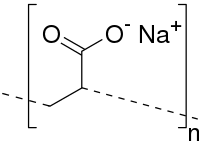
Photo from wikipedia
Abstract Water holding capacity becomes essential for hygiene applications including baby diapers. Microfibers of hydrophilic polymers have been useful source for such applications. While, super hydrophilic and stable nanofibers incorporation… Click to show full abstract
Abstract Water holding capacity becomes essential for hygiene applications including baby diapers. Microfibers of hydrophilic polymers have been useful source for such applications. While, super hydrophilic and stable nanofibers incorporation with functional antibacterial agent are essential to get higher absorption of water along with antimicrobial activity against harmful bacteria. In current work, hydrophobic polymeric nanofibers are transformed to super hydrophilic nanofibers by addition of copper (II) oxide (CuO hereafter) nanoparticles. CuO nanoparticles provided two distinctive properties to existing nanofibers. Firstly, nanofibers surface area was significantly increased, and secondly copper (II) oxide itself is hydrophilic material which imparted hydrophilicity to base polymer. Polyacrylonitrile, crosslinked Polyvinyl Alcohol, and PICT were selected as super hydrophobic polymeric nanofibers. Copper II oxide nanoparticles (same concentration) were added in all polymer solution and electrospun. Surface, morphological, and hydrophilic properties were characterized and it was concluded that copper II oxide is suitable for transforming hydrophobic nanofibers to super hydrophilic nanofibers. Water holding capacity (WHC) was also improved for all prepared nanofiber mats. WHC for PVA/CuO, PAN/CuO, and PICT/CuO were recorded an average of 23 g/g, 21 g/g, and 18 g/g respectively. Combining all useful results from possible characterization of nanofiber mats, it is expected that CuO nanoparticles loaded nanofibers will have potential application as antibacterial, sustainable, and stable replacement of hygiene products.
Journal Title: Polymer Testing
Year Published: 2020
Link to full text (if available)
Share on Social Media: Sign Up to like & get
recommendations!